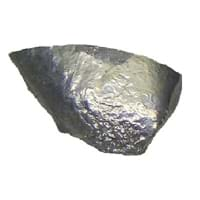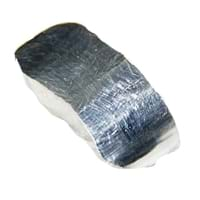Iridium Indium Comparison
Periodic Table
Symbol
Ir
In
Group Number
9
9
13
5
Period Number
6
5
Block
d block
p block
Element Family
Transition Metal
Post-Transition
CAS Number
7439885
99+
7440746
17
Space Group Name
Fm_ 3m
I4/mmm
Space Group Number
225.00
2
139.00
8
Facts
Interesting Facts
- Iridium element occurs as natural alloys of Platinum and Osmium.
- Iridium element is known as the most corrosion resistance metal .
- Luster of Indium is bright in nature.
- Reich and richer were looking for thallium in zinc metal and they discovered Indium metal.
Sources
Found in Minerals, Mining, Ores of Minerals
Mining, Ores of metals
History
Who Discovered
Smithson Tennant
Ferdinand Reich and Hieronymous Theodor Richter
Discovery
In 1803
In 1863
Abundance
Abundance In Universe
2 * 10-7 %
22
3 * 10-8 %
28
Abundance In Sun
~0.0000002 %
25
~0.0000004 %
23
Abundance In Meteorites
0.00 %
29
0.00 %
99+
Abundance In Earth's Crust
0.00 %
99+
0.00 %
99+
Abundance In Oceans
Not Available
0.00 %
99+
Uses
Uses & Benefits
- Iridium has an anti corrosion properties and it is used in special alloy with Osmium metal and that alloy is used in pen tips and compass bearings.
- It is used to produce indium tin oxide (ITO), it is used in manufacturing touch screens, flat screen TVs and solar panels.
- Its nitride, phosphide and antimonide are used in transistors and microchips.
Industrial Uses
Automobile Industry, Electrical Industry, Electronic Industry
Aerospace Industry, Automobile Industry
Medical Uses
NA
Medical Research
Other Uses
Alloys
Alloys, In Nuclear Reactors
Biological Properties
Toxicity
Toxic
Non Toxic
Present in Human Body
Yes
Yes
Physical Properties
Melting Point
2,410.00 °C
7
156.61 °C
99+
Boiling Point
4,527.00 °C
10
2,000.00 °C
99+
Appearance
Physical State
Solid
Solid
Color
Silvery White
Silvery Gray
Luster
Metallic
Lustrous
Hardness
Mohs Hardness
6.50
5
1.20
20
Brinell Hardness
1,670.00 MPa
5
8.80 MPa
99+
Vickers Hardness
1,760.00 MPa
3
Not Available
Speed of Sound
4,825.00 m/s
13
1,215.00 m/s
99+
Optical Properties
Reflectivity
78.00 %
6
Not Available
Allotropes
No
No
α Allotropes
Not Available
Not Available
β Allotropes
Not Available
Not Available
γ Allotropes
Not Available
Not Available
Chemical Properties
Chemical Formula
Ir
In
Isotopes
Known Isotopes
34
5
35
4
Electronegativity
Pauling Electronegativity
2.20
4
1.78
16
Sanderson Electronegativity
Not Available
2.14
8
Allred Rochow Electronegativity
1.55
11
1.49
13
Mulliken-Jaffe Electronegativity
Not Available
1.76
10
Allen Electronegativity
1.68
17
1.66
18
Electropositivity
Pauling Electropositivity
1.80
99+
2.22
38
Ionization Energies
1st Energy Level
880.00 kJ/mol
9
558.30 kJ/mol
99+
2nd Energy Level
1,600.00 kJ/mol
35
1,820.70 kJ/mol
18
3rd Energy Level
Not Available
2,704.00 kJ/mol
39
4th Energy Level
Not Available
5,210.00 kJ/mol
17
Electrochemical Equivalent
1.14 g/amp-hr
99+
1.43 g/amp-hr
99+
Electron Work Function
4.55 eV
13
4.12 eV
24
Other Chemical Properties
Flammable, Ionization, Radioactive Isotopes, Radioactivity
Ionization, Radioactive Isotopes, Radioactivity, Solubility
Atomic Properties
Atomic Number
77
39
49
99+
Electron Configuration
[Xe] 4f14 5d7 6s2
[Kr] 4d10 5s2 5p1
Crystal Structure
Face Centered Cubic (FCC)
Tetragonal (TETR)
Crystal Lattice
FCC-Crystal-Structure-of-Iridium.jpg#100
TETR-Crystal-Structure-of-Indium.jpg#100
Atom
Number of Protons
74
99+
49
99+
Number of Neutrons
110
27
66
99+
Number of Electrons
74
99+
49
99+
Radius of an Atom
Atomic Radius
136.00 pm
99+
167.00 pm
24
Covalent Radius
141.00 pm
99+
142.00 pm
99+
Van der Waals Radius
202.00 pm
27
193.00 pm
31
Atomic Weight
192.22 amu
34
114.82 amu
99+
Atomic Volume
9.53 cm3/mol
99+
15.70 cm3/mol
33
Adjacent Atomic Numbers
Valence Electron Potential
140.00 (-eV)
5
54.00 (-eV)
25
Lattice Constant
383.90 pm
26
325.23 pm
99+
Lattice Angles
π/2, π/2, π/2
π/2, π/2, π/2
Lattice C/A Ratio
Not Available
Not Available
Mechanical Properties
Density
Density At Room Temperature
22.56 g/cm3
10
7.31 g/cm3
99+
Density When Liquid (at m.p.)
19.00 g/cm3
3
7.02 g/cm3
33
Tensile Strength
2,000.00 MPa
2
2.50 MPa
21
Viscosity
Not Available
Not Available
Vapor Pressure
Vapor Pressure at 1000 K
Not Available
0.01 (Pa)
11
Vapor Pressure at 2000 K
0.00 (Pa)
25
Not Available
Elasticity properties
Shear Modulus
210.00 GPa
2
Not Available
Bulk Modulus
320.00 GPa
3
Not Available
Young's Modulus
528.00 GPa
1
11.00 GPa
99+
Poisson Ratio
0.26
22
Not Available
Other Mechanical Properties
NA
Ductile, Malleable
Magnetic Properties
Magnetic Characteristics
Specific Gravity
21.78
3
7.31
99+
Magnetic Ordering
Paramagnetic
Diamagnetic
Electrical Properties
Electrical Property
Conductor
Conductor
Resistivity
47.10 nΩ·m
99+
83.70 nΩ·m
34
Electrical Conductivity
0.19 106/cm Ω
10
0.12 106/cm Ω
17
Electron Affinity
151.00 kJ/mol
4
28.90 kJ/mol
31
Thermal Properties
Specific Heat
0.13 J/(kg K)
39
0.23 J/(kg K)
27
Molar Heat Capacity
25.10 J/mol·K
99+
26.74 J/mol·K
25
Thermal Conductivity
147.00 W/m·K
10
81.80 W/m·K
21
Critical Temperature
Not Available
Not Available
Thermal Expansion
6.40 µm/(m·K)
99+
32.10 µm/(m·K)
9
Enthalpy
Enthalpy of Vaporization
799.10 kJ/mol
1
226.40 kJ/mol
40
Enthalpy of Fusion
35.23 kJ/mol
1
3.28 kJ/mol
99+
Enthalpy of Atomization
837.00 kJ/mol
1
242.70 kJ/mol
99+
Standard Molar Entropy
35.50 J/mol.K
99+
57.80 J/mol.K
22
|
||
|
||
|












